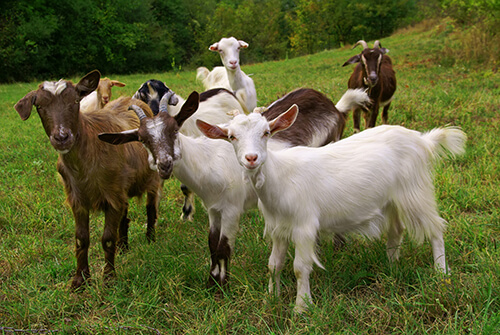Tips for Trimming Your Goat’s Hooves
Aug 01, 2022

Fair season is here, and youth exhibitors across the state are preparing their goats for upcoming shows. But even those who never find themselves in the show ring may find it beneficial to own these versatile animals as they provide meat, milk, and weed control.
Proper trimming of your animals’ hooves is an important part of being a responsible livestock owner. Because goats’ metabolism is so fast, they must be able to constantly move around and graze. However, they will not be able to do so if their feet hurt due to overgrown and untended hooves.
Learn how to trim your goat’s hooves on your own by following the 4-step process laid out below:
Step 1: Trim the hoof wall
The best time to trim your goat’s hooves is right after a rain or morning dew, when the hoof wall is soft from the moisture. Begin by cleaning out the surface dirt and rocks from the sole of your goat’s hoof and between their toes. Using a hoof trimmer, carefully peel back the overgrown hoof wall and cut it away from the sole. Overgrown hooves will fold over, covering the bottom of the hoof. Trim the walls until they are level with the sole, but do not take too big of cuts or you may cause the hoof to bleed.
Step 2: Trim the sole
Once the sole is exposed, use a hoof knife to remove any old sole. When the sole appears clean, white, and slightly pinkish, you have trimmed deep enough. Spend extra time on areas with hoof rot, which is most likely to occur around the tip of the toe and along the hoof walls.
Step 3: Trim the toe and heel
Cut off excess toe and trim between the hooves where the heels come together. Because the heel is the softest part of the hoof, use extra caution when using sharp trimmers or hoof knives in this sensitive area. Use a file to round off the toe and complete the job.
Step 4: Trim the dew claws
Your goat’s dew claws may need to be trimmed if they become long, dry, or crusty. While this is not something you generally have to worry about in younger goats, older goats tend to need more dew claw attention. Carefully trim the dew claws one small snip at a time — you can always take more off, but you can’t put it back on.
Although it may take a few tries for your goats to become accustomed to the hoof care process, once you develop a regular routine, it can become a pleasant experience for both parties involved. Visit your local Co-op for hoof care and other goat supplies such as feed, mineral, and show supplies.
For more content like this, check out the latest issue of the Cooperator.
Proper trimming of your animals’ hooves is an important part of being a responsible livestock owner. Because goats’ metabolism is so fast, they must be able to constantly move around and graze. However, they will not be able to do so if their feet hurt due to overgrown and untended hooves.
Learn how to trim your goat’s hooves on your own by following the 4-step process laid out below:
Step 1: Trim the hoof wall
The best time to trim your goat’s hooves is right after a rain or morning dew, when the hoof wall is soft from the moisture. Begin by cleaning out the surface dirt and rocks from the sole of your goat’s hoof and between their toes. Using a hoof trimmer, carefully peel back the overgrown hoof wall and cut it away from the sole. Overgrown hooves will fold over, covering the bottom of the hoof. Trim the walls until they are level with the sole, but do not take too big of cuts or you may cause the hoof to bleed.
Step 2: Trim the sole
Once the sole is exposed, use a hoof knife to remove any old sole. When the sole appears clean, white, and slightly pinkish, you have trimmed deep enough. Spend extra time on areas with hoof rot, which is most likely to occur around the tip of the toe and along the hoof walls.
Step 3: Trim the toe and heel
Cut off excess toe and trim between the hooves where the heels come together. Because the heel is the softest part of the hoof, use extra caution when using sharp trimmers or hoof knives in this sensitive area. Use a file to round off the toe and complete the job.
Step 4: Trim the dew claws
Your goat’s dew claws may need to be trimmed if they become long, dry, or crusty. While this is not something you generally have to worry about in younger goats, older goats tend to need more dew claw attention. Carefully trim the dew claws one small snip at a time — you can always take more off, but you can’t put it back on.
Although it may take a few tries for your goats to become accustomed to the hoof care process, once you develop a regular routine, it can become a pleasant experience for both parties involved. Visit your local Co-op for hoof care and other goat supplies such as feed, mineral, and show supplies.
For more content like this, check out the latest issue of the Cooperator.